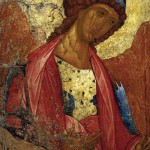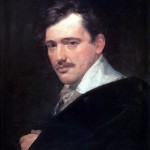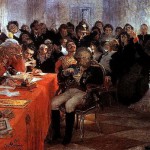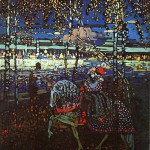Andrei Rublev (с.1360-c.1427)
- The Archangel Gabriel, 1408. Cycle icons of the Deesis row of iconostasis of the Dormition Cathedral in Vladimir.
- The Archangel Michael from the Deesis row, 1414.
- Gregory The Theologian, 1408. Cycle icons of the Deesis row of iconostasis of the Dormition Cathedral in Vladimir.
- The Savior, 1410.
- The Descent into the Hell, 1408-1410.
- Savior in His Might, 1408
- The Nativity Of Christ. The Annunciation Cathedral of the Moscow Kremlin.
- Holy Trinity, 1410.
Andrei Rublev is a Russian medieval iconographer who combined formal ascetism with emotional expression. This style became the template for religious painting of its time and has fascinated artists through the ages.
Little is known about his life. He worked at the turn of the 14th and 15th century with other lauded masters such as Theophanes the Greek and Prokhor of Gorodets. The artists decorated the Cathedral of the Annunciation of the Moscow Kremlin. There is a record of Rublev painting the Assuption Cathedral in Vladimir and the frescoes of the Savior Cathedral in Moscow's Andronicov Monastery, where he remained until his death.
Because of the wide influence of Andrei Rublev's style, ascertaining the extent of Rublev's entire oeuvre has been difficult and attributions will continue to be made and refuted.
Andrei Rubluv's masrepiece of the gentle spirit of The Old Testament Trinity was widely copied and well known.
Karl Bryullov(1799-1852)
- Death of Inessa de Castro. 1834
- Karl Pavlovich Bryullov: Self-portrait. 1848
- Walk. 1849
- Mark the Evangelist. 1843-1847
- Odalisque. 1823-1835
- Portrait of AN Demidov. 1831-1852
- Portrait of AN Lvov. 1824
- The Last Day of Pompeii
Karl Bryllov is one of the greatest names of the 19th century Russian painting.
At the age of nine Karl Bryullov became a pupil at the Academy of Arts in Saint Petersburg. He began his studies in the historical painting class of the Academy of Fine Arts. When he graduated he set off for Italy as beneficiaries of the newly founded Society for the Encouragement of Artists.
Bryullov saw beauty in many sensations in life, in the immediacy of human feeling, in simple, everyday things. His studio in Rome was a popular meeting place. His friends included the composer Mikhail Glinka and A.K. Tolstoy, the brothers Turgenev, and Zinaida Volkonskaya.
His famous painting "The Last Day of Pompeii" (1830-1835), showing the tragedy of the Roman city destroyed when Vesuvius erupted (first century AD). The action in the picture occupies an enormous area. Karl Bryullov succeeded in conveying the most valuable thing in people-love of one's neighbour.
In the autumn of 1833, The Last Day of Pompeii began its triumphant tour of exibitions all over Europe, from Rome and Milan to Paris and St.Petersburg. Its success was enormous. The head of thee Italian art school, Vincenzo Camuccini, declared Bryullov a 'colossus' of an artist. Sir Walter Scott, who visited his studio, called hiscreation an epic. Bryullov was elected honorary member of the Academies of Milan, Bologna, Florence and Parma.
On December 25, 1835 the artist returned to Moscow, and in May he went to St. Petersburg. The portrait gallery of his contemporaries which Bryullov priduced in St. Petersburg are real gems of Russian portraiture.
Self-Portrait, painted when he was ill, is one of the most realistic and profound character studies and a kind of autobiography of the artist.
Ilya Repin (1844-1930)
- A. S. Pushkin in the Lyceum on January 8th, 1815 reads his poem Memories in Tsarskoe Selo. 1911
- Blessing the Little Children (the Gospel Story). 1890s
- Self-portrait. 1894
- Duel. 1897
- Man’s Best Friend (Dog). 1908
- Barge Haulers on the Volga
- On the Trail. 1881
- Jesus with Crown of Thorns. 1913
In 1871 Ilya Repin was awarded with the highest prise of the Academy of Fine Arts. The Grand Gold Medal was given to the artist for a painting on a Gospel subject, 'Raising of Jairus' Daughter' and as addition Repin received a scholarship abroad.
'Barge Haulers on the Volga' is one of the Repin's most famous works. Repin's treatment of the theme goes beyond the limits of a genre painting and attains a high level of visual and social generalization.
'Zaporozhian Cossacks Write a Letter to the Turkish Sultan'(1878-1891) is a very popular work of Repin's in the Russian Museum collection. The painting surprised Repin's contemporaries with its triumphant vitality.
Repin portrayed musicians ( Borodin, Rimsky-Korsakov, Rubinstein), writers (Stasov,Leo Tolstoi). The author of 'War and Peace' is depicted as an old peasant, bare-headed and barefoot, his hands tucked into the belt of his blouse.
In the early 20th century, Repin's works were considered as an artistic symbol of Russian folk spirit.
Mikhail Vrubel (1856-1910)
- 1884 Pentecote, Detail II
- self portrait 1905
- the Demon sitting 1890
- pan 1899
- swan-princess 1900
- muse 1896
- Guido
- Christ
The work of Mikhail Vrubel is among the most complex phenomena in Russian art of the turn of the 19th and 20th century. The personality was significantly influenced by his lineage ( he had Polish, Russian and Danish roots) and frequent moves from place to place in connection with his father's work.
Vrubel was an exceptional phenomenon in Russian Art, with his many skills and peerless depth of talent.Vrubel exibited the great energy and vast innovative capabilities characteristic of Russian art. In the development of fine arts, Vrubel's work was of innovative, revolutionary significance. His Demon theme is an eternal, universal image, like the images of Mephistipheles, Faust and Hamlet.
His unique religious church paintings were unrivalled in their monumental depth of penitration into the spirit.
Vrubel's exploration of epic national themes and immersion into folklore poetry far surpassed the greatest achivements of his contemporaries.
The artist left his indelible mark in the areas of mounted pictures (portraits and landscapes), in decorative painting(panels) and 'communicated with nature' through his still life work.
He started a new step in the development of theatrical decorative art, and ressurrected ceramic art in Russia and was also a highly talented sculptor.
Today, parallels are drawn between the work of Vrubel and the fin-de-siele movement of Aubrey Beardsley, the symbolism of the modernists Franz von Stuck and Gustav Klimpt, the expressionism of Vincent Van Gogh and Edvard Munch, synthetism of Paul Gauguin and works of the leading representative of the 'Nabis' group, Maurice Denis.
Wassily Kandinsky (1866-1944)
- Amazon. 1911
- White oval. 1919
- Two horse. 1906
- Moscow I. 1916
- Yellow-red-blue. 1925
- Autumn Landscape with boats. 1908
- Черный аккомпанемент. 1924
- The Blue Rider. 1903
Wassily Kandinsky is generally considered to be the 'Father of Abstract Art' who changed art forever. The birth of abstraction appeared when Kandinsky began focusing on creating works of pure colour and abstract shape. His paintings can provoke an emotional response akin to listening to classical music.
Kandinsky graduated from the University of Moscow in 1892 and then lectured there law and economics. In 1896 he refused an offer of a professorship in the Department of Law at the University of Dorpat in Russia, and went to Munich to become an artist.
Kandinsky is also famous for his influential essay, 'Concerning the Spiritual in Art' (1910) where he displayed himself as the first great philosopher and theorist of abstract art. By 1911, Kandinsky had formed the avant-garde group 'The Blue Rider' together with artist Franz Mark. In 1922 Kandinsky was appointed a professor at the Bauhaus School in Berlin. When the school was closed in 1933 Kandinsky moved into exile in Paris, where he spent the rest of his life.
The Hermitage Museum in St. Petersburg, Russia and the Russian Museum in Saint Petersburg boast having paintings of the prominent Russian artist Wassily Kandinsky.







































